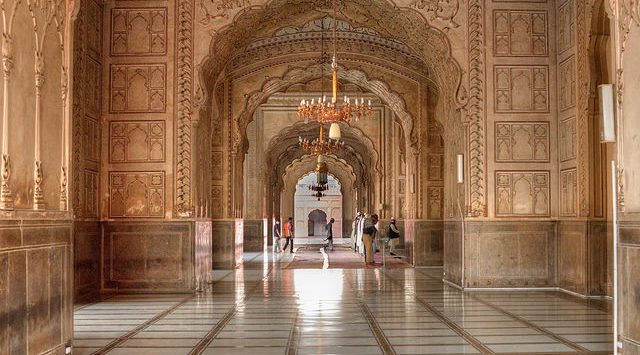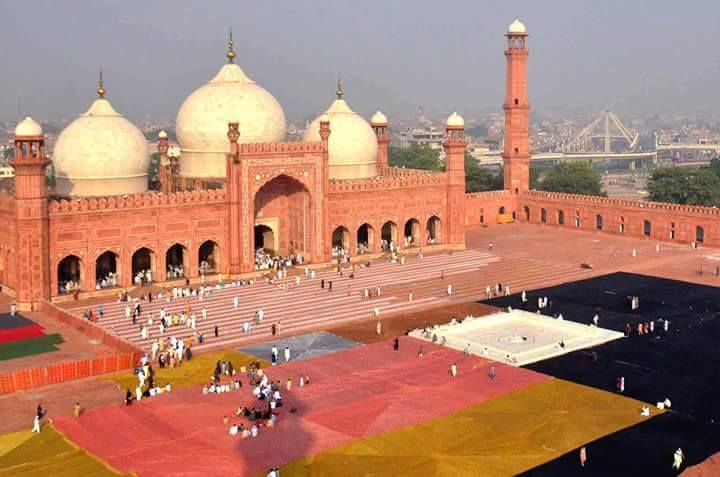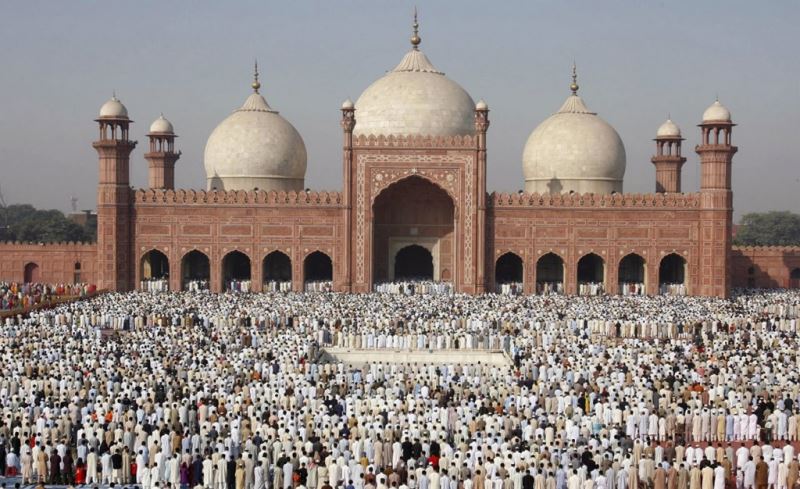The Badshahi Mosque, also called as “Emperor’s Mosque,” located in Lahore, Pakistan.
It was built by Aurangzeb Alamgir, the sixth Mughal Emperor.
The construction of the mosque took about two years, completed in 1673.
The Badshahi Mosque symbolizes the sense of aesthetics and magnificence of the Mughal Empire. Also displays an excellent example of Mughal architecture. Furthermore introduce the great power and spirituality of Islam.
The architectural design and structure of the mosque is quite similar to the Jama Masjid in Delhi, India, constructed by Aurangzeb's father Shah Jahan, in 1656.
 The Jama Mosque alone did not serve as inspiration for the Badshahi Mosque, however. Other obvious influences include Indo-Greek, Indian, and Central Asian architecture.
The Jama Mosque alone did not serve as inspiration for the Badshahi Mosque, however. Other obvious influences include Indo-Greek, Indian, and Central Asian architecture.
You can discover in Pakistan many sacred destinations that both cater to your cultural curiosity as well your fondness for fine art.
Badshahi Mosque is one of the most recognized place in this respect.
Now, so many years after its construction, it remains the fifth largest mosque in the entire world and the second largest in Pakistan and South Asia as a whole.
The only mosques larger than it, are the Faisal Mosque in Islamabad, the Grand Mosque of Mecca, the Prophet’s Mosque in Medina, and the Hassan II Mosque in Casablanca.
At the time of its construction, no one had ever seen or imagined a mosque the size of the Badshahi Mosque. Even to this day, it is still quite amazing in terms of its size and overall grandeur.
It was the largest mosque in the world during the seventeenth century, for a long time.
The mosque was built opposite to the Lahore Fort, illustrating the combined impression of beauty and grace with strength and power of Mughal Empire.

Lahore Fort is one of the masterpiece and the star attraction of the Old City.
Upon achieving its independence in 1947, Pakistan has uplifted the Badshahi Mosque and Fort Lahore as symbols of the nation.
The mosque is built on a raised platform, which is reached by a flight of 22 steps.
The mosque lived thorough many distressed days during Sikh hegemony, under the reign of Maharaja Ranjit Singh.
During this period Badshahi Mosque was damaged badly. Rubies, gold, and other valuables were plundered. The mosque's courtyard was used as a stable for their horses and camels. Furthermore, Sikhs forbade Muslims from entering the mosque to worship.
Even when the British took control of India, they used the mosque for military training center.
In the 1840 earthquake many of the minarets, especially their tops, were badly damaged.
However, almost all damages have now been restored, providing the Badshahi Mosque to its original design and structure.
Beginning from 1852, piecemeal repairs were carried out. Extensive repairs were done later from 1939 to 1960 which brought the mosque to its original shape and condition.
In 2008, replacement work commenced on the red sandstone tiles at the mosque's large courtyard, to bring it to be nearly restored.
The mosque features a massive main prayer hall.
The main prayer hall of the mosque comprises of seven arches. These arches have been supported by seven enormous heavy piers.
All parts of the main prayer hall are heavily decorated, including stucco and fresco work and marble.
The interior of the mosque is adorned donatılmış with precious and semi-precious stones in floral motifs.
The interior is floored in marble.

The main prayer hall is divided into seven compartments by engraved arches.
Three of these compartments contains rooms which are used for teaching purpose.
On the top of the middle, there are three domes, one main and two minor which is a common feature of Mughal architecture.
Recently a small museum has been added to the mosque complex, which contains some relics of Prophet Hz.Muhammad, his cousin Hz.Ali, and his daughter Hz. Fatima Zahra. Among these relics are a turban, a coat, a hat, trousers, and a slipper with a foot imprint captured in stone.
The exterior is decorated with marble inlay on red sandstone, specially of loti form motifs in bold relief. The embellishment has Indo-Greek, Central Asian and Indian architectural influence both in technique and motifs.
The courtyard measures 25.000 square meter being the largest in the world. The floor of the courtyard was paved with small kiln-burnt bricks.
At each of the four corners of the mosque, there is an octagonal, three storeyed minaret of red sandstone which has an open, marble-covered canopy. The minarets are (60 m) tall. They are visible from almost 15 km. away.
The main building of the mosque also features additional four small minarets in its each corner which gives extra topping of beauty to the Mosque.
The main prayer hall can accommodate 10.000 people indoors and almost 100.000 in the courtyard.
Muhammad Iqbal, Pakistani Islamic scholar, poet, philosopher and also leader of the Pakistan Movement was buried in an elegant tomb which is located next to the main entrance of the Badshahi Mosque.
On the occasion of the 2nd Islamic Summit held at Lahore on 22th.of February 1974, thirty-nine heads of Muslim states offered their Friday prayers in the Badshahi Mosque, including, among others, Zulfiqar Ali Bhutto of Pakistan, Faisal of Saudi Arabia, Muammar Gaddafi of Libya, Yasser Arafat of the Palestine Liberation Organisation and Sabah III Al-Salim Al-Sabah of Kuwait.
Özden Atukeren
Yeni Asya English